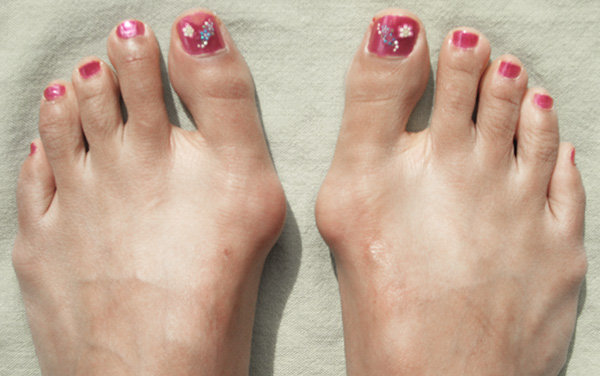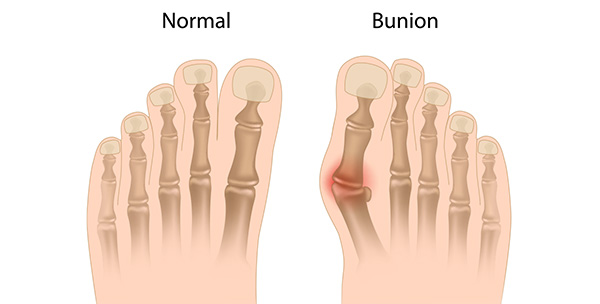Bunion, also known as Hallux Abducto Valgus Deformity, is misalignment of the big toe joint. It occurs when the big toe moves towards the 2nd toe, at times crossing under or over it in more severe cases. As a result, the first metatarsal (the bone behind the big toe) starts shifting towards the midline of your body, creating a painful “bump” on the side of the foot which can be an area of pressure or friction with shoe gear. There will often be redness and swelling in this area.

Bunions are hereditary. It occurs more often in females than males.
A bunionette or Tailor’s Bunion is very similar to a bunion except it occurs at the 5th toe joint with a bump on the outside of the foot. It also occurs due to a misalignment of the joint. This condition can be an isolated deformity or it can be associated with a bunion.

The big toe joint is malaligned in most bunion deformities.
Studies show women are 10 times more likely to develop a bunion and family history is a strong factor with this condition. Furthermore, bunions are often associated with an unstable foot type or flatfoot (fallen arches). This deformity may occur early on (pediatric bunion or Juvenile Hallux Abducto Valgus) or later in life, depending on each individual. As stated above, pain and swelling may occur at the “bump” or deep in the big toe joint. In certain cases, pain can also develop under the 2nd toe joint (metatarsalgia) or hammertoe may occur.
Causes
Bunions form when the normal balance of forces that is exerted on the joints and tendons of the foot becomes disrupted. This disruption can lead to instability in the joint and cause the deformity. Bunions are brought about by years of abnormal motion and pressure over the MTP joint. They are, therefore, a symptom of faulty foot development and are usually caused by the way we walk and our inherited foot type or our shoes. Bunions also tend to run in families.
Symptoms:

Some bunions are asymptomatic while others may experience pain over the “bump” or deep in the big toe joint. Footwear limitations are often associated with bunions.
- Development of a firm bump on the outside edge of the foot, at the base of the big toe.
- Redness, swelling, or pain at or near the MTP joint.
- Corns of other irritations caused by the overlap of the first and second toes.
- Restricted or painful motion of the big toe
Treatment
Treatment options vary with the type and severity of each bunion, although identifying the deformity early in its development is important in avoiding surgery. The primary goal of most early treatment options is to relieve pressure on the bunion and halt the progression of the joint deformity.
A foot specialist may recommend one or more of these treatments:
Padding and Taping
Often the first step in a treatment plan, padding the bunion minimizes pain and allows the patient to continue a normal, active life. Taping helps keep the foot in a normal position, thus reducing stress and pain.
Medication
Anti-inflammatory drugs and cortisone injections are often prescribed to ease the acute pain and inflammation caused by joint deformities.
Physical Therapy
Often used to provide relief of the inflammation and bunion pain. Ultrasound therapy is a popular technique for treating bunions and their associated soft tissue involvement.
Orthotics
Shoe inserts may be useful in controlling foot function and may reduce symptoms and prevent worsening of the deformity. Visit Orthotics for more information.
Surgical Options
When early treatments fail or the bunion progresses past the threshold for such options, foot surgery may become necessary to relieve pressure and repair the toe joint. Several surgical procedures are available. The surgery will remove the bony enlargement, restore the normal alignment of the toe joint, and relieve pain.

If pain persists despite conservative treatment, surgical correction of bunion can reduce pain significantly. Bunion surgery aims to re-align the big toe joint, improving its function.
Untreated bunion may cause not only progression of this deformity, but also degenerative changes can occur at the big toe joint, making ambulation and activities very painful. Bunions can be asymptomatic and not all bunions need to be treated surgically. There are a wide range of treatment options available, from conservative to surgical. Learn more about surgical correction.

Before and after bunion surgery.
Our experience shows that not all bunions are same, thus each case needs to be evaluated uniquely. If you are concerned about your bunion or if you are having symptoms, let our foot specialist help guide you through your treatment options. Contact us for a consultation.

